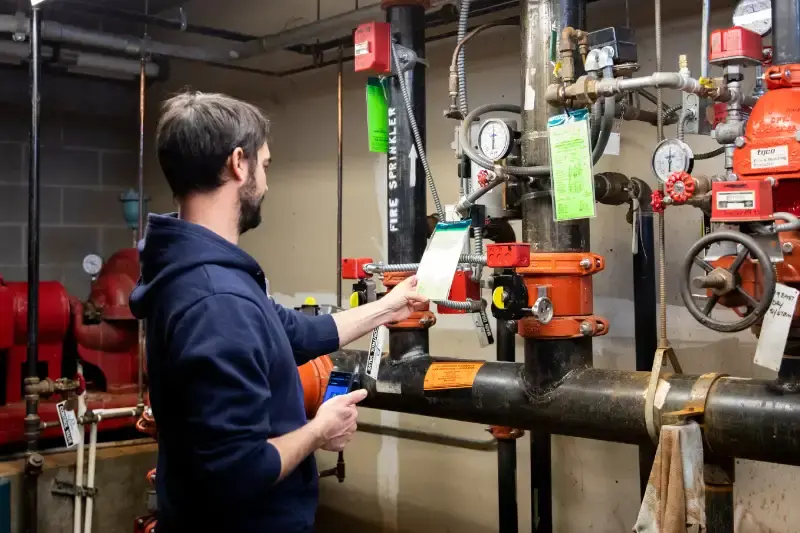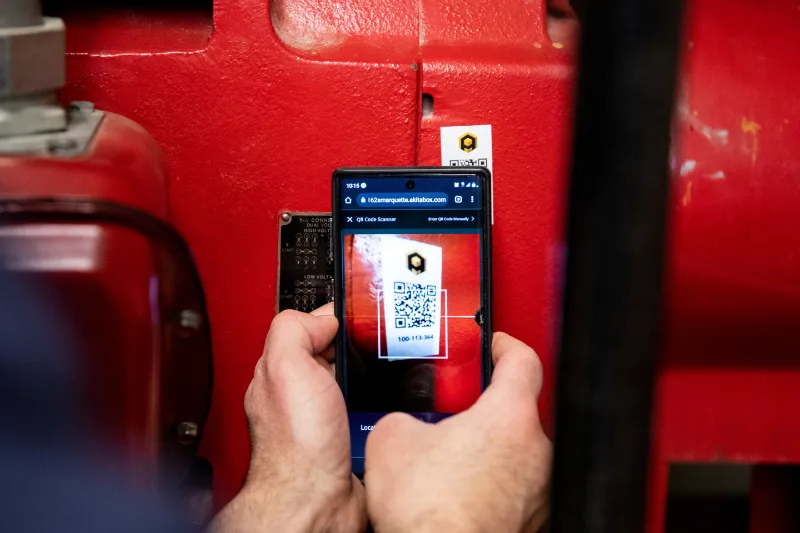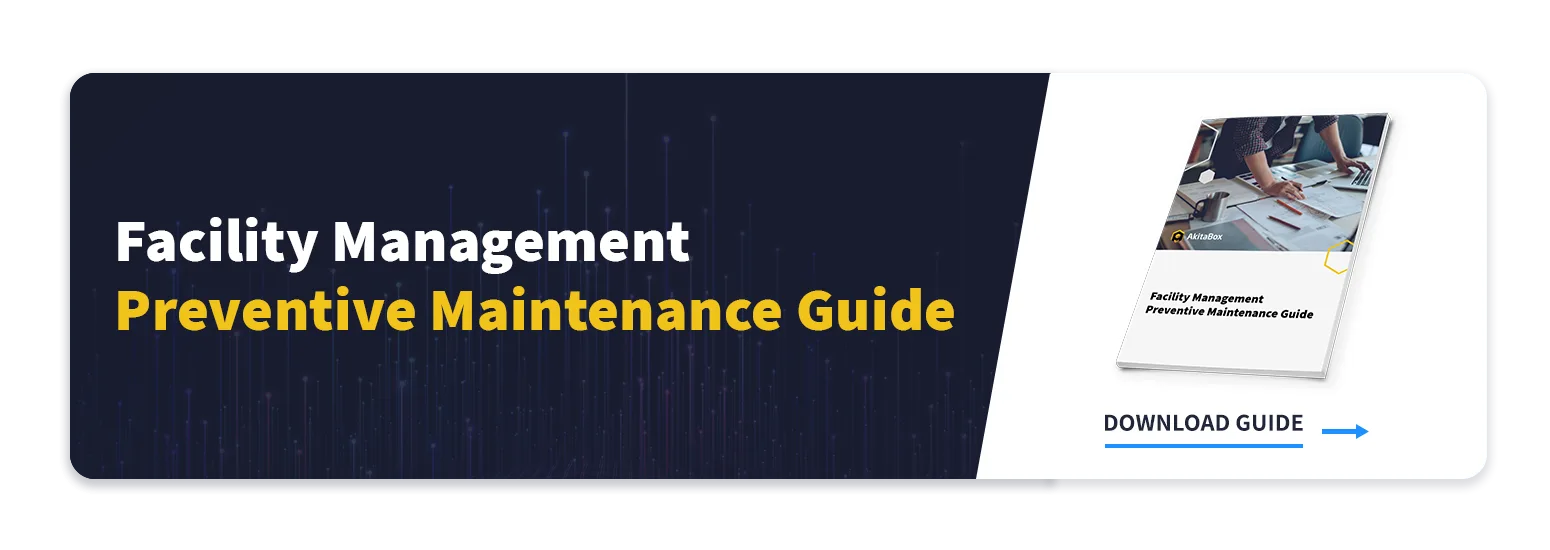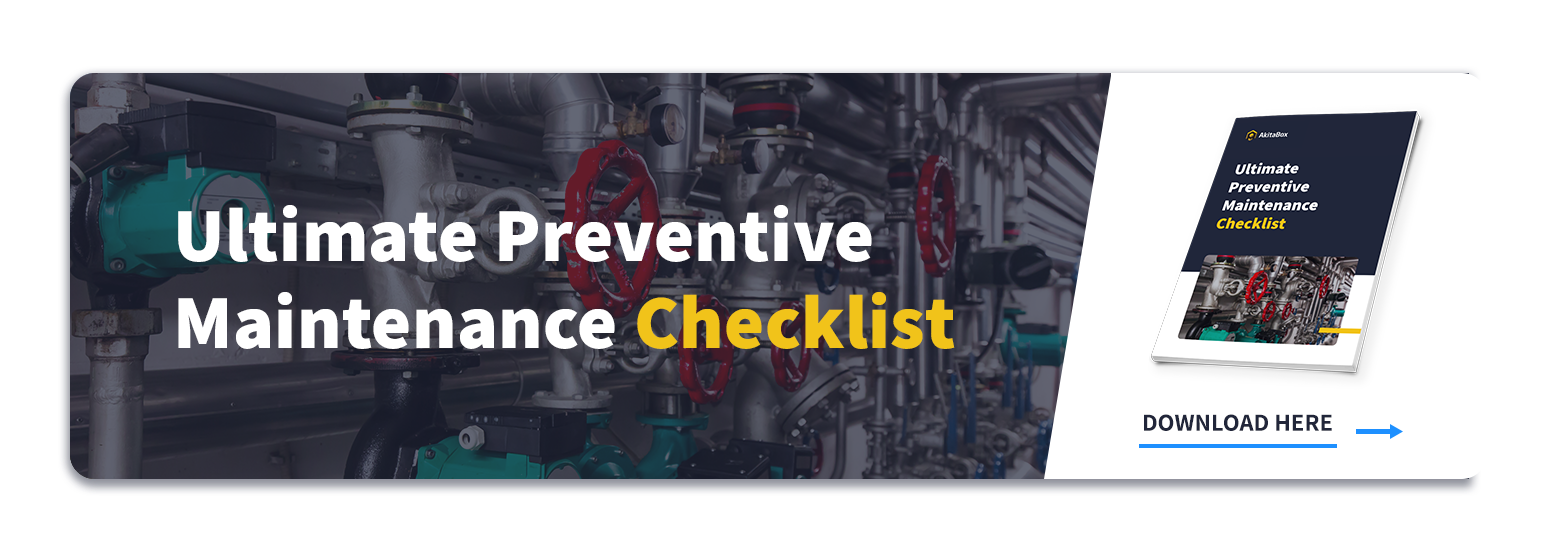You already know preventive is better than reactive when it comes to asset maintenance. Who wants to waste thousands of dollars a year because of inconsistent, after-the-fact repairs? Or be the one to explain to the big bosses that you’ll have to spend piles of money to rush in an emergency replacement asset because your old one died? Not me. And I’m betting not you, either.
But HOW do you move from reactive to proactive maintenance? This guide can help you get started.
Preventive Maintenance Guide for Facilities Table of Contents
Click any of the following links to jump straight to the topic you’re looking for.
-
What is preventive maintenance?
-
The four main components of preventive maintenance
-
Key benefits of preventive maintenance
-
Reactive vs. preventive maintenance
-
Types of preventive maintenance
-
Using preventive maintenance to reduce risk
-
How to create a preventive maintenance program
-
More resources on preventive maintenance
What is preventive maintenance?
Preventive maintenance (also sometimes called “preventative” maintenance) aims to predict and prevent catastrophic equipment failures before they occur. To do this, facilities personnel conduct routine inspections, maintenance, and repairs on assets to ensure they’re functioning properly and efficiently – instead of waiting until the asset breaks down or starts acting up. Functioning equipment means you can focus less on reactive maintenance and more on upcoming maintenance tasks or time-sensitive work orders.

It’s better to prevent issues than react to them. By taking the necessary steps to ensure assets are performing optimally, preventive maintenance drastically reduces the likelihood of unexpected issues. Examples of preventive maintenance actions include:
- Scheduling and performing regular inspections of equipment
- Conducting regular cleaning of buildings, grounds, and assets
- Lubricating moving parts to reduce wear and tear
- Adjusting controls for optimal performance and energy efficiency
- Repairing and replacing any defective equipment parts
What are the Four Main Components of Preventive Maintenance?
Inspection: Inspections are necessary for two reasons. First, facility inspections ensure that equipment is safe to use. They help prevent workplace injuries and increase liability protection. Second, regular inspections protect property by ensuring that equipment is functioning as the manufacturer intended.
Detection: Operating on a run-to-failure approach can end up costing a facility department significant money. Preventive maintenance helps facility managers detect problems early, when issues are still relatively easy and inexpensive to fix.
Correction: Preventive maintenance corrects issues before they occur. If an issue (or potential issue) is detected, facility managers promptly address the problem before it worsens or shuts down operations.
Prevention: Facility managers analyze inspection records and maintenance notes to learn from past mistakes and correct repeated issues with equipment. Preventing asset failure reduces stress and increases productivity for facilities teams. When equipment works as it’s supposed to, staff can focus on proactive (rather than reactive) maintenance tasks.
What are the Benefits of Preventive Maintenance?
Preventive maintenance has two overarching goals: to increase asset longevity and productivity and to keep people and assets safe from harm. The principles of preventive maintenance enable you to:
- Diminish excess depreciation of equipment
- Prevent untimely breakdowns of critical equipment
- Eliminate unnecessary inspections and maintenance tasks
- Save money by extending the useful life of assets
- Prepare for and prevent future issues from occurring
Reactive vs. Preventive Maintenance
Reactive maintenance focuses on diagnosing and fixing a problem once an asset has already broken down or malfunctioned. A maintenance technician identifies the issue and takes steps to restore the asset to operational condition.
Preventive maintenance emphasizes regularly scheduled maintenance tasks. The goal is to give an asset the care it requires while it’s still running. This approach actively minimizes the chance of failure, costly repairs, and unscheduled downtime.
Read More: Preventive vs. Reactive Maintenance: What’s the Difference?

A common misconception is that reactive maintenance is a bad thing. The truth is that most facilities departments experience a healthy balance between reactive maintenance and preventive maintenance throughout the year. That’s because it’s nearly impossible to predict and prevent all asset failures. Things can and will go wrong.
However, you want to minimize the amount of reactive maintenance whenever possible. After all, nobody enjoys dealing with a broken air conditioner or leaky pipe.
What are the Different Types of Preventive Maintenance?
Preventive maintenance can follow a time-based approach, a usage-based approach, or a combination of the two. Let’s look at examples of each.
Time-based Preventive Maintenance
Time-based preventive maintenance goes by a variety of names, a main one being “calendar-based” maintenance. No matter which term your department uses, this approach involves setting up a preventive maintenance schedule to perform regular inspections on pieces of equipment, especially those that would have a severe impact on production in the event of a breakdown.
Time-based preventive maintenance is best used for bounded assets (such as fire/safety equipment) and critical assets (such as HVAC systems and pumps), though you can use this approach for any asset that requires preventive maintenance. For example:
- “Inspect parking lot for cracks once a month”
- “Change air handling unit filters every three months”
- “Inspect water heaters semi-annually”
Usage-based Preventive Maintenance
Usage-based maintenance, also called “runtime maintenance,” is an approach that triggers maintenance after a certain amount of asset runtime (such as every “X” amount of kilometers, miles, hours, or production cycles).
Unlike time-based maintenance, which occurs on a more rigid schedule, usage-based maintenance occurs as often as an asset needs it, whether it’s every month or every six months. For example:
- “Inspect belts every 100 hours of production”
- “Service motor vehicles every 5,000 miles”
- “Lubricate pumps every 10,000 run-hours”
How Can Preventive Maintenance Reduce Risk in My Facility?
All facilities face potential risks which, left unchecked, can put workers, occupants, and the mission of an organization in jeopardy. As a facility professional, you’re responsible for securing these risks and ensuring safety in your facilities. A strong preventive maintenance plan can effectively reduce the two types of risk to your buildings.
Preventive maintenance reduces risk to people
Facility managers have the power to prevent injuries and reduce employees’ days spent away from work. Preventive maintenance supports the safety and security of equipment for all occupants.
You can keep people safe by conducting recurring maintenance and inspections on dangerous machinery. Do the same with security cameras, door locks, fire extinguishers, emergency exit signs, and any other asset that safeguards people from harm.
Preventive maintenance reduces risk to property
Reactive maintenance can be expensive. It’s not cheap when an asset breaks down unexpectedly, including costs to diagnose the issue, replace parts, and ultimately fix the problem. Preventive maintenance can dramatically reduce the likelihood of these risks.
Facility managers should implement routine asset checks and planned maintenance to avoid costly fixes down the road. Use this Facility Inspection Preparation Checklist to determine assets you should regularly inspect.
How Do I Create a Preventive Maintenance Program that Actually Works?
Many facility managers like the idea of preventive maintenance, but quickly become frustrated by not knowing where to start. The good news is that implementing a proactive process can be painless if building teams develop a solid strategy and use the right tools.
The quickest, easiest way to support a winning preventive maintenance program is by using facility management software like AkitaBox. Cutting-edge software not only automates preventive maintenance tasks for you, it’ll also replace bulky stacks of paper and cluttered spreadsheets. Software holds your team accountable and gives them instant access to asset information and preventive maintenance protocols in the field.

And that’s not the only way AkitaBox software can help your team with preventive maintenance.
Location-based asset mapping helps you find and service equipment
Location-based asset mapping means every single asset is placed onto your digital floor plan as a pin. You can filter your assets to see only the asset pins you need. This feature is especially useful if a team member is assigned to inspect or service all assets of a certain type (i.e. inspect all emergency exit signs for burnt out bulbs) as part of a preventive maintenance program.
Work order and PM scheduling modules create recurring preventive maintenance tasks and procedures
AkitaBox makes work order management and preventive maintenance scheduling easy. Triage incoming service requests by building or floor, assign work orders to specific team members, and receive automatic reminders of upcoming preventive maintenance tasks.
AI-powered data collection creates a complete, accurate asset inventory
Knowing what assets you have ensures nothing is overlooked in your preventive maintenance schedule. With AkitaBox Capture AI-powered data collection, just snap a photo of an asset’s manufacturer label and the software does the rest. Collect data at the speed of walking your building and create a comprehensive asset inventory you can trust.
Upload asset documentation, receipts, and O&M manuals for easy reference
AkitaBox stores all of your facility and asset documentation in one central, easy-to-access place. You can instantly access needed documents in the field – no more running back and forth to the plan room or sifting through file cabinets..
Stay informed on preventive maintenance success with data reporting dashboards
As facility managers, we are data-driven and want to see evidence of success (or the need for improvement) through numbers. AkitaBox facility management software includes multiple reporting dashboards showing information such as number of overdue work orders, work orders by asset, and so much more. Seeing this information helps you identify potential problems and also highlight areas where your department shines.
Access PM information for assets out in the field on mobile devices
Facility management software gets your team up, moving, and accomplishing more work throughout the day. You’re no longer tied to your desktop computer and printer, since AkitaBox can function on any mobile device and eliminates the need to print out work orders for preventive maintenance tasks.
Scan QR codes to view preventive maintenance work orders for an asset
A QR code is a type of barcode that can be placed on equipment and assets within a facility. Use a mobile device with a camera to scan an asset’s QR code and viola! Your team can instantly see the asset’s PM history, as well as any upcoming maintenance tasks to be completed.

Where Can I Find More Free Resources on Preventive Maintenance?
Read AkitaBox’s Ultimate Preventive Maintenance Guide
Flipping your facility to a preventive maintenance model doesn’t need to be challenging. Break the cycle of reactive maintenance with AkitaBox’s Preventive Maintenance Guide, a free guide that gives you the information and tools you need to be successful.
Download AkitaBox’s Preventive Maintenance Checklist
Keep the focus on preventive maintenance versus reactive maintenance with the Ultimate Preventive Maintenance Checklist. This step-by-step checklist covers asset identification, naming conventions, and data collection accuracy.
Check out AkitaBox’s Guide to Understanding and Implementing Preventive Maintenance
Thinking of implementing a new or improved preventive maintenance plan for your facilities? The Guide to Understanding and Implementing Preventive Maintenance covers the foundation of a proactive strategy, tips and tricks to implement a PM plan, and a timeline to fully implement and perfect your program.
Speak with a facility management industry advisor
It’s a good idea to contact a facility management professional who can coach you through preventive maintenance best practices that will best suit your building and industry. Our friendly team is here to help and will work with you to identify the right processes and tools for you. You can contact us here.
Implementing Preventive Maintenance in Your Facility
Preventive maintenance can seem like an overhead cost that is, at first, difficult to justify. But you know that all it takes is one serious accident or significant period of downtime to demonstrate how important it is to take a proactive approach.
By staying ahead of maintenance and repair needs, your organization will realize major cost savings and higher asset reliability. AkitaBox’s Preventive Maintenance Guide explains how to develop a PM plan based on accurate asset data and secure the necessary budget. It’s a great place to start your PM journey.

